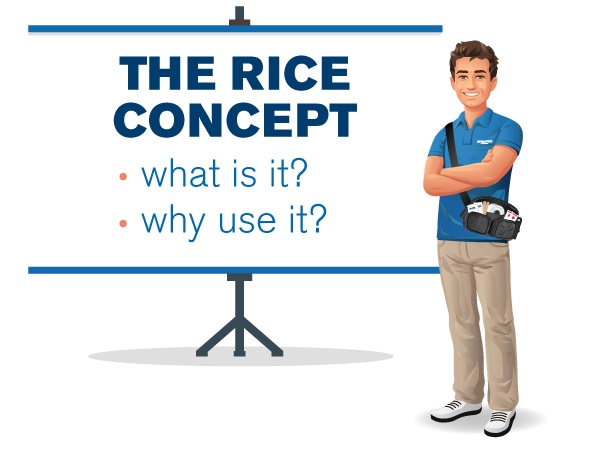
RICE- For Eating or For Injury? Why not both!?!
Leave a CommentIt’s my favorite time of year – spring sports are starting, the weather is getting warmer AND it’s March… National Athletic Training Month!
Every year the National Athletic Trainers Association has a slogan for National Athletic Training Month. This year’s slogan is “ATs are Health Care.” In this post I’ll discuss one of the tools that athletic trainers have in our ever-expanding tool bag to help compassionately care for the patients and athletes we treat – RICE.
While I do enjoy rice pilaf and cilantro lime rice, I’m not talking about the edible RICE. I’m talking about the acronym R.I.C.E., which stands for Rest, Ice, Compression and Elevation. It is a concept that can be applied for any muscle, joint, or ligament injury to relieve pain, control swelling and help promote early healing.
So WHAT do you do in each step and WHY does it help?
First up, REST
Possibly the hardest thing for athletes to do is to take a break. Athletic trainers don’t want you to be sitting out for a long period, but we do want to help you get back to your sport as healthy and safely as possible. Sometimes a little rest is what your body needs to get back quicker. By taking a break you let the healing process begin. Let your body be your guide. Any activity that increases pain or discomfort should be stopped. Why should you rest? By continuing activity, you may increase damage and it may lead to further injury (either to your initial injury or a new injury altogether), which is something no one wants.
Second, ICE
Apply ice packs to the injured area for 10-15 minutes at a time, three or more times a day. Do not apply the ice directly to the skin. Instead, wrap the ice pack in a towel before applying. Cold helps to reduce pain and swelling, which is the first step in the recovery process. Getting a head start on this process will ensure a speedy recovery.
Next up, COMPRESSION
This part can be combined with ice or applied solo. Applying a compression wrap will help to reduce swelling, increase circulation and provide support to the injured area. The tricky part is to make sure the compression wrap isn’t too tight. It should be snug enough that you have support but doesn’t make your extremities (i.e. fingers and toes) turn colors or cause an increase in pain to the injured area.
Finally, ELEVATION
Prop it up! Sit back and relax, you know the first letter? R for Rest. Keeping the injured body part above your heart will encourage the swelling to be absorbed by the rest of your body. Remember, reducing and controlling swelling is a key component to having a speedy recovery!
A Healthy and Speedy Recovery
That’s it. Easy peasy right? Doing these small things can help ensure a healthy and speedy recovery! Remember, one of our goals as athletic trainers is to get you back out there as healthy, safely and fast as possible.
If you’d like more information on RICE or would like to have an injury evaluated, contact your local Athletico to schedule a free assessment.
Happy National Athletic Training Month!
The Athletico blog is an educational resource written by Athletico employees. Athletico bloggers are licensed professionals who abide by the code of ethics outlined by their respective professional associations. The content published in blog posts represents the opinion of the individual author based on their expertise and experience. The content provided in this blog is for informational purposes only, does not constitute medical advice and should not be relied on for making personal health decisions.
